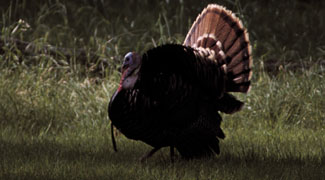|
Gobbler
Gurus
Turkeys take top priority with Tech teachers |
||||
| by Jeremy Derington | ||||
|
|
||||
 Turkeys.
It conjures up multiple images. Wild Turkey for the bartender. Cold turkey
for those wrestling a bad habit. The buffoon down the hall. He’s a
turkey, right? If Ben Franklin had had his way, the fleshy fowl would have
adorned our flagpoles as the national bird. And for children tracing their
first big Thanksgiving turkey–an outline of their hand on construction
paper, the thumb as the head and neck–turkeys mean pilgrims. Turkeys.
It conjures up multiple images. Wild Turkey for the bartender. Cold turkey
for those wrestling a bad habit. The buffoon down the hall. He’s a
turkey, right? If Ben Franklin had had his way, the fleshy fowl would have
adorned our flagpoles as the national bird. And for children tracing their
first big Thanksgiving turkey–an outline of their hand on construction
paper, the thumb as the head and neck–turkeys mean pilgrims.According to Dr. Warren Ballard, associate professor of range, wildlife, and fisheries management, turkeys did mean pilgrims. "Prior to European establishment the Rio Grande turkey had a population of around 2 million," he said. "That number fell to approximately 100,000 before 1930." The same students that celebrated Thanksgiving making turkeys out of construction paper and crayons are now getting hands-on experience dealing with wild turkeys. Students from Texas Tech and Kansas State universities are taking the opportunity to gain experience in research and wildlife habitat management through a comprehensive research project conducted at research sites in the Texas Panhandle and southern Kansas. Texas Tech’s department of range, wildlife and fisheries management has teamed up with Texas Parks and Wildlife, the Kansas Department of Wildlife and Parks, the National Wild Turkey Federation, the Texas Chapter of the National Wild Turkey Federation and Kansas State University to fund and conduct research to develop ways to increase the number of Rio Grande turkeys. "This study is the most comprehensive and largest study ever conducted on the Rio Grande turkey or any turkey in North America," said Dr. Mark Wallace, assistant professor of range, wildlife and fisheries management. Ballard and Wallace are supervising the project, but Wallace says the students are the ones getting the experience. "We have one doctoral student, four masters students and about 20 undergraduate students working on the project," Wallace said. Wallace said it is a valuable and unique experience for all the students involved. "It’s something they wouldn’t normally have an opportunity to do. They are studying things that have never been studied before," he said. "The population of Rio Grande turkeys in northern Texas, Oklahoma and Kansas have not been keeping up with the numbers in South Texas and Mexico," Wallace said. "We want to figure out why." The Rio Grande turkey ranks second in total population among the five subspecies of wild turkey falling behind the eastern wild turkey. In the 1930s successful efforts increased the number of Rio Grande wild turkeys. "The Rio Grande turkey population has not kept up with other turkey subspecies. We suspect that part of the problem is habitat management. We hope to correct this by focusing on landscapes as they relate to turkey populations," Ballard said. This study has some very unique characteristics that set it apart from any other study. "Landscape management as it relates to turkey mortality rates and survival has not ever been studied on this scale," Wallace said. "Furthermore, we are studying the turkeys at different ages and different sexes. We are studying turkey poults, which has never been done before," he said. "This study will provide us with a complete picture of the patterns and habits of the Rio Grande turkey and will help us better manage habitats to aid in reestablishing an abundant population," Ballard said. Ballard says that after gathering the data, specific land use principles can be developed to help landowners better manage land to aid in reestablishing turkey populations. "We hope to make a number of land and population managment recommendations that will be implemented on lands managed by Texas Parks and Wildlife and Kansas Department of Wildlife and Parks," he said. Recommendations will also be formulated for private land owners who wish to improve their properties for wild turkeys. |
||||